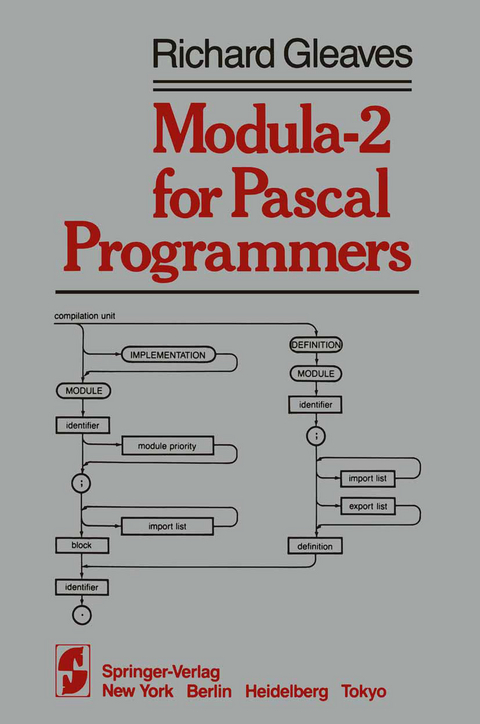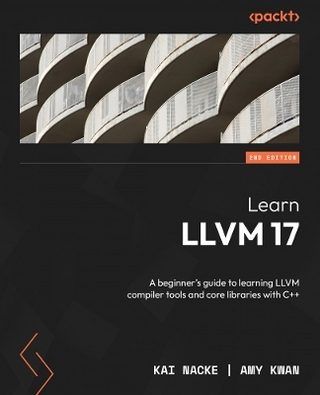
Modula-2 for Pascal Programmers
Seiten
1984
|
Softcover reprint of the original 1st ed. 1984
Springer-Verlag New York Inc.
978-0-387-96051-7 (ISBN)
Springer-Verlag New York Inc.
978-0-387-96051-7 (ISBN)
This book describes the programming language Modula-2. Some readers will recognize this book as being based upon the Volition Systems Modula-2 User's Manual. I wish to thank the following people and organizations for their contributions to the development of this book: Volition Systems, for giving me the opportunity to write about Modula-2;
This book describes the programming language Modula-2. It is written for people who know the Pascal language and who wish to learn Modula-2 in terms of their knowledge of Pascal. The text is divided into three parts. Part 1 introduces concepts unique to Modula-2 and thus new to Pascal programmers. Part 2 describes differences from Pascal. Part 3 defines modules which provide basic programming facilities. The appendices include a glossary and syntax diagrams. Please note that this book does not offer a complete description of the Modula-2 language; it is intended to complement Niklaus Wirth's definitive book Programming in Modula-2 (Springer-Verlag, 1983). Some readers will recognize this book as being based upon the Volition Systems Modula-2 User's Manual. Enough has changed to merit its reappearance in this more dignified form: existing material has been reorganized to improve clarity; new material has been added to improve content. This book was written with the ASE text editor. The text was produced in camera-ready form on the Scenic LaserTezt composition system. I wish to thank the following people and organizations for their contributions to the development of this book: Volition Systems, for giving me the opportunity to write about Modula-2; Jim Merritt, for reviewing an early draft; the Institut far Informatik, ETH Zarich, for publishing a series of informative technical papers on Modula-2; and finally, all the pioneer users of Volition Systems Modula-2, for their patience and foresight and support.
This book describes the programming language Modula-2. It is written for people who know the Pascal language and who wish to learn Modula-2 in terms of their knowledge of Pascal. The text is divided into three parts. Part 1 introduces concepts unique to Modula-2 and thus new to Pascal programmers. Part 2 describes differences from Pascal. Part 3 defines modules which provide basic programming facilities. The appendices include a glossary and syntax diagrams. Please note that this book does not offer a complete description of the Modula-2 language; it is intended to complement Niklaus Wirth's definitive book Programming in Modula-2 (Springer-Verlag, 1983). Some readers will recognize this book as being based upon the Volition Systems Modula-2 User's Manual. Enough has changed to merit its reappearance in this more dignified form: existing material has been reorganized to improve clarity; new material has been added to improve content. This book was written with the ASE text editor. The text was produced in camera-ready form on the Scenic LaserTezt composition system. I wish to thank the following people and organizations for their contributions to the development of this book: Volition Systems, for giving me the opportunity to write about Modula-2; Jim Merritt, for reviewing an early draft; the Institut far Informatik, ETH Zarich, for publishing a series of informative technical papers on Modula-2; and finally, all the pioneer users of Volition Systems Modula-2, for their patience and foresight and support.
1 New Concepts.- 1. Modules.- 2. Separately Compiled Modules.- 3. Program and Subprogram Modules.- 4. Utility Modules.- 5. The Module Library.- 6. Low-level Programming.- 7. Coroutines and Interrupts.- 8. Procedure Variables.- 2 Differences From Pascal.- 9. Vocabulary.- 10. Constants.- 11. Types.- 12. Expressions.- 13. Statements.- 14. Procedures and Functions.- 15. Standard Procedures.- 16. Blocks.- 3 Utility Modules.- 17. Standard I/O.- 18. Text I/O.- 19. File I/O.- 20. Terminal I/O.- 21. Storage Management.- 22. Subprogram Calls.- 23. Strings.- 24. Format Conversion.- 25. Math Functions.- App. A Glossary.- App. B Syntax Diagrams.- App. C Reserved Words and Symbols.- App. D Standard Identifiers.- App. E ASCII Character Set.
| Reihe/Serie | Springer Books on Professional Computing |
|---|---|
| Zusatzinfo | 145 p. |
| Verlagsort | New York, NY |
| Sprache | englisch |
| Maße | 155 x 235 mm |
| Themenwelt | Schulbuch / Wörterbuch ► Lexikon / Chroniken |
| Mathematik / Informatik ► Informatik ► Programmiersprachen / -werkzeuge | |
| Informatik ► Theorie / Studium ► Compilerbau | |
| ISBN-10 | 0-387-96051-1 / 0387960511 |
| ISBN-13 | 978-0-387-96051-7 / 9780387960517 |
| Zustand | Neuware |
| Haben Sie eine Frage zum Produkt? |
Mehr entdecken
aus dem Bereich
aus dem Bereich
a beginner's guide to learning llvm compiler tools and core …
Buch | Softcover (2024)
Packt Publishing Limited (Verlag)
49,85 €


